Anna Pavlova (1881–1931) was a Russian prima ballerina of the late 19th and the early 20th centuries. She was a principal artist of the Imperial Russian Ballet and the Ballets Russes of Sergei Diaghilev. Pavlova is most recognized for the creation of the role The Dying Swan and, with her own company, became the first ballerina to tour ballet around the world. She also appeared in a Hollywood film.
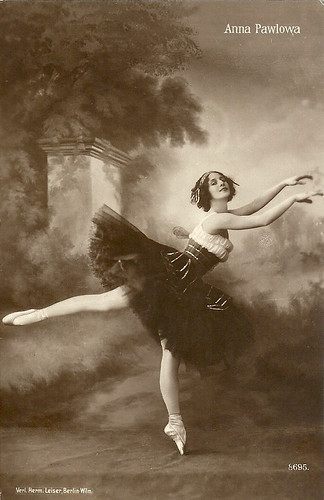
German postcard by Verlag Hermann Leiser, no. 8695. Collection: Didier Hanson.
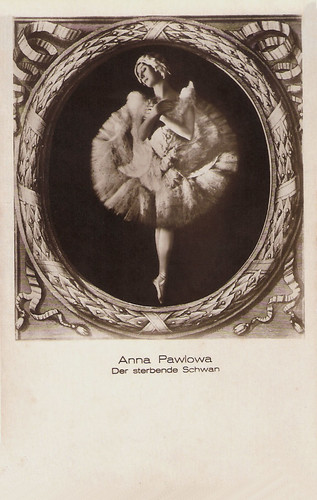
German postcard. Caption: Anna Pavlova in The Dying Swan.
Anna Pavlovna (Matveyevna) Pavlova (Russian: Анна Павлова) was born in 1881 in Ligovo, near Saint Petersburg, in the Russian Empire to unwed parents. Her mother, Lyubov Feodorovna, was a laundress. Her father was rumoured to have been Jewish (some sources state that her biological father was the banker Lazar Polyakov). Her mother's second husband, Matvey Pavlov, is believed to have adopted her at the age of three, by which she acquired his last name.
Pavlova's passion for the art of ballet was ignited when her mother took her to a performance of Marius Petipa's original production of The Sleeping Beauty at the Imperial Maryinsky Theater. The lavish spectacle made an impression on Pavlova. At the age of nine, her mother took her to audition for the renowned Imperial Ballet School. Because of her youth, and what was considered her 'sickly' appearance, she was not chosen.
In 1891, she was finally accepted at the age of 10. She appeared for the first time on stage in Marius Petipa's Un conte de fées (A Fairy Tale), which the ballet master staged for the students of the school. Young Pavlova's years of training were difficult. Classical ballet did not come easily to her. Her severely arched feet, thin ankles, and long limbs clashed with the small and compact body in favour for the ballerina at the time.
Her fellow students taunted her with such nicknames as The broom and La petite sauvage (The little savage). Undeterred, Pavlova trained to improve her technique. She would practice and practice after learning a step. She took extra lessons from the noted teachers of the day — Christian Johansson, Pavel Gerdt, Nikolai Legat — and from Enrico Cecchetti, considered the greatest ballet virtuoso of the time and founder of the Cecchetti method, a very influential ballet technique used to this day.
In 1898, she entered the classe de perfection of Ekaterina Vazem, former Prima ballerina of the Saint Petersburg Imperial Theatres. During her final year at the Imperial Ballet School, she performed many roles with the principal company. She graduated in 1899 at age 18, chosen to enter the Imperial Ballet a rank ahead of corps de ballet as a coryphée.
She made her official début at the Mariinsky Theatre in Pavel Gerdt's Les Dryades prétendues (The False Dryads). Her performance drew praise from the critics, particularly the great critic and historian Nikolai Bezobrazov. At the height of Petipa's strict academicism, the public was taken aback by Anna Pavlova's style, a combination of a gift that paid little heed to academic rules: she frequently performed with bent knees, bad turnout, misplaced port de bras and incorrectly placed tours. Such a style in many ways harked back to the time of the romantic ballet and the great ballerinas of old.
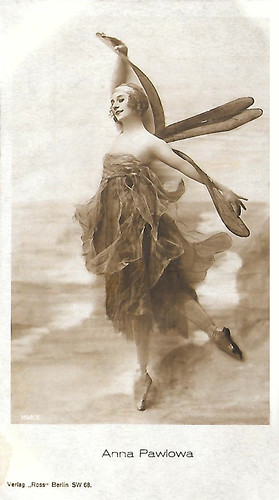
German postcard by Ross Verlag, Berlin, no. 1540/2, 1927-1928. Collection: Didier Hanson.
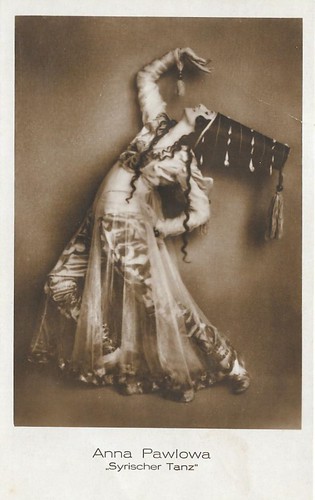
German postcard. Collection: Didier Hanson. Caption: Anna Pavlova in Syrian Dance.
Anna Pavlova performed in various classical variations, pas de deux and pas de trois in such ballets as La Camargo, Le Roi Candaule, Marcobomba and The Sleeping Beauty. Her enthusiasm often led her astray: once during a performance as the River Thames in Petipa's The Pharaoh's Daughter her energetic double pique turns led her to lose her balance, and she ended up falling into the prompter's box.
Her weak ankles led to difficulty while performing as the fairy Candide in Petipa's The Sleeping Beauty, leading the ballerina to revise the fairy's jumps en pointe, much to the surprise of the Ballet Master. She tried desperately to imitate the renowned Pierina Legnani, Prima ballerina assoluta of the Imperial Theaters. Once during class she attempted Legnani's famous fouettés, causing her teacher Pavel Gerdt to fly into a rage.
Pavlova rose through the ranks quickly, becoming a favourite of the old maestro Petipa. It was from Marius Petipa himself that Pavlova learned the title role in Paquita, Princess Aspicia in The Pharaoh's Daughter, Queen Nisia in Le Roi Candaule, and Giselle. She was named danseuse in 1902, première danseuse in 1905, and finally prima ballerina in 1906 after a resounding performance in Giselle. Petipa revised many grand pas for her, as well as many supplemental variations.
She was much celebrated by the fanatical balletomanes of Tsarist Saint Petersburg, her legions of fans calling themselves the Pavlovatzi. When the ballerina Mathilde Kschessinska was pregnant in 1901, she coached Pavlova in the role of Nikya in La Bayadère. Kschessinska, not wanting to be upstaged, was certain Pavlova would fail in the role, as she was considered technically inferior because of her small ankles and lithe legs. Instead audiences became enchanted with Pavlova and her frail, ethereal look, which fitted the role perfectly, particularly in the scene The Kingdom of the Shades.
Her feet were extremely rigid, so she strengthened her pointe shoe by adding a piece of hard wood on the soles for support and curving the box of the shoe. At the time, many considered this 'cheating', for a ballerina of the era was taught that she, not her shoes, must hold her weight en pointe. In Pavlova's case this was extremely difficult, as the shape of her feet required her to balance her weight on her little toes. Her solution became, over time, the precursor of the modern pointe shoe, as pointe work became less painful and easier for curved feet.
According to Margot Fonteyn's biography, Pavlova did not like the way her invention looked in photographs, so she would remove it or have the photographs altered so that it appeared she was using a normal pointe shoe. Pavlova is perhaps most renowned for creating the role of The Dying Swan, a solo choreographed for her by Michel Fokine. The ballet, created in 1905, is danced to Le cygne from The Carnival of the Animals by Camille Saint-Saëns. Pavlova also choreographed several solos herself, one of which is The Dragonfly, a short ballet set to music by Fritz Kreisler. While performing the role, Pavlova wore a gossamer gown with large dragonfly wings fixed to the back.
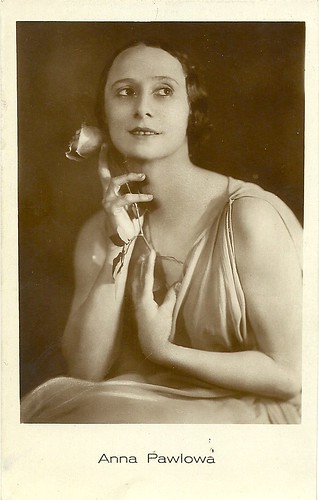
Vintage postcard. Collection: Didier Hanson.
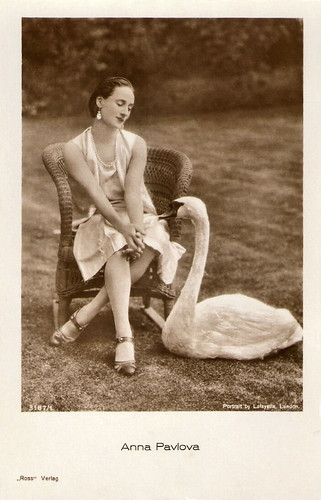
German postcard by Ross Verlag, no. 3187/1, 1928-1929. Photo: Lafayette, London.
From 1908 till 1914, in the first years of the Ballets Russes, Anna Pavlova worked briefly for Sergei Diaghilev. Originally she was to dance the lead in Mikhail Fokine's The Firebird, but refused the part, as she could not come to terms with Igor Stravinsky's avant-garde score, and the role was given to Tamara Karsavina.
All her life Pavlova preferred the melodious 'musique dansante' of the old maestros such as Cesare Pugni and Ludwig Minkus, and cared little for anything else which strayed from the salon-style ballet music of the 19th century. By the early 20th century she had founded her own company and performed throughout the world, with a repertory consisting primarily of abridgements of Petipa's works, and specially choreographed pieces for herself. Members of her company included Kathleen Crofton.
After leaving Russia, Pavlova moved to London, England, settling, in 1912, at the Ivy House on North End Road, Golders Green, north of Hampstead Heath, where she lived for the rest of her life. The house had an ornamental lake where she fed her pet swans, and where now stands a statue of her by the Scots sculptor George Henry Paulin. While in London, Pavlova was influential in the development of British ballet, most notably inspiring the career of Alicia Markova.
Pavlova was introduced to audiences in the United States by Max Rabinoff during his time as managing director of the Boston Grand Opera Company from 1914 to 1917 and was featured there with her Russian Ballet Company during that period. In Hollywood, she met many film stars, including Charlie Chaplin and Mary Pickford.
She also starred in a silent film, The Dumb Girl of Portici (Phillips Smalley, Lois Weber, 1916). Bob Lipton in his review at IMDb: "Unhappily, while it probably worked very well at the time -- at least to the extent of letting audiences see the prima ballerina of the Russian ballet and in making it clear that real artists of the real arts would do movies -- this movie has not aged well. The melodramatic plot was typical of grand opera of the period, but modern tastes in stories are less grandiose and Miss Pavlova, while she moves beautifully, is clearly a stage actress and does not know how to tone down her performance for the screen."
While touring in The Hague, Pavlova was told that she had pneumonia and required an operation. She was also told that she would never be able to dance again if she went ahead with it. She refused to have the surgery, saying "If I can't dance then I'd rather be dead." She died of pleurisy, in the bedroom next to the Japanese Salon of the Hotel Des Indes in The Hague, three weeks short of her 50th birthday. In accordance with old ballet tradition, on the day she was to have next performed, the show went on as scheduled, with a single spotlight circling an empty stage where she would have been.
Memorial services were held in the Russian Orthodox Church in London. Anna Pavlova was cremated, and her ashes placed in a columbarium at Golders Green Crematorium, where her urn was adorned with her ballet shoes (which have since been stolen). Victor Dandré, her manager and companion, asserted he was her husband in his biography of the dancer in 1932: Anna Pavlova: In Art & Life. According to IMDb, he had married her in 1924. Pavlova's life was depicted in the TV series Anna Pavlova (Emil Loteanu, 1983), starring Galina Belyaeva.

With Charlie Chaplin. German postcard by Ross Verlag, Berlin, no. 1843/1, 1927-1928. Collection: Didier Hanson.
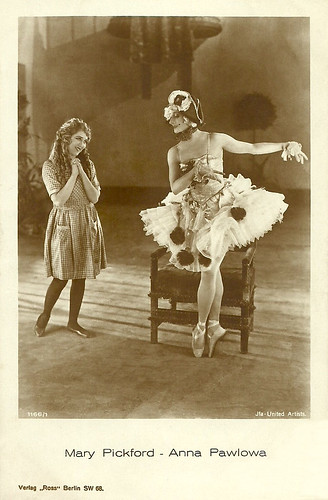
With Mary Pickford. German postcard by Ross Verlag, Berlin, no. 1166/1, 1927-1928. Photo: United Artists.
Sources: Bob Lipton (IMDb), Steve Shelokhonov (IMDb), Wikipedia and IMDb.

German postcard by Verlag Hermann Leiser, no. 8695. Collection: Didier Hanson.

German postcard. Caption: Anna Pavlova in The Dying Swan.
The little savage
Anna Pavlovna (Matveyevna) Pavlova (Russian: Анна Павлова) was born in 1881 in Ligovo, near Saint Petersburg, in the Russian Empire to unwed parents. Her mother, Lyubov Feodorovna, was a laundress. Her father was rumoured to have been Jewish (some sources state that her biological father was the banker Lazar Polyakov). Her mother's second husband, Matvey Pavlov, is believed to have adopted her at the age of three, by which she acquired his last name.
Pavlova's passion for the art of ballet was ignited when her mother took her to a performance of Marius Petipa's original production of The Sleeping Beauty at the Imperial Maryinsky Theater. The lavish spectacle made an impression on Pavlova. At the age of nine, her mother took her to audition for the renowned Imperial Ballet School. Because of her youth, and what was considered her 'sickly' appearance, she was not chosen.
In 1891, she was finally accepted at the age of 10. She appeared for the first time on stage in Marius Petipa's Un conte de fées (A Fairy Tale), which the ballet master staged for the students of the school. Young Pavlova's years of training were difficult. Classical ballet did not come easily to her. Her severely arched feet, thin ankles, and long limbs clashed with the small and compact body in favour for the ballerina at the time.
Her fellow students taunted her with such nicknames as The broom and La petite sauvage (The little savage). Undeterred, Pavlova trained to improve her technique. She would practice and practice after learning a step. She took extra lessons from the noted teachers of the day — Christian Johansson, Pavel Gerdt, Nikolai Legat — and from Enrico Cecchetti, considered the greatest ballet virtuoso of the time and founder of the Cecchetti method, a very influential ballet technique used to this day.
In 1898, she entered the classe de perfection of Ekaterina Vazem, former Prima ballerina of the Saint Petersburg Imperial Theatres. During her final year at the Imperial Ballet School, she performed many roles with the principal company. She graduated in 1899 at age 18, chosen to enter the Imperial Ballet a rank ahead of corps de ballet as a coryphée.
She made her official début at the Mariinsky Theatre in Pavel Gerdt's Les Dryades prétendues (The False Dryads). Her performance drew praise from the critics, particularly the great critic and historian Nikolai Bezobrazov. At the height of Petipa's strict academicism, the public was taken aback by Anna Pavlova's style, a combination of a gift that paid little heed to academic rules: she frequently performed with bent knees, bad turnout, misplaced port de bras and incorrectly placed tours. Such a style in many ways harked back to the time of the romantic ballet and the great ballerinas of old.

German postcard by Ross Verlag, Berlin, no. 1540/2, 1927-1928. Collection: Didier Hanson.

German postcard. Collection: Didier Hanson. Caption: Anna Pavlova in Syrian Dance.
The Dying Swan
Anna Pavlova performed in various classical variations, pas de deux and pas de trois in such ballets as La Camargo, Le Roi Candaule, Marcobomba and The Sleeping Beauty. Her enthusiasm often led her astray: once during a performance as the River Thames in Petipa's The Pharaoh's Daughter her energetic double pique turns led her to lose her balance, and she ended up falling into the prompter's box.
Her weak ankles led to difficulty while performing as the fairy Candide in Petipa's The Sleeping Beauty, leading the ballerina to revise the fairy's jumps en pointe, much to the surprise of the Ballet Master. She tried desperately to imitate the renowned Pierina Legnani, Prima ballerina assoluta of the Imperial Theaters. Once during class she attempted Legnani's famous fouettés, causing her teacher Pavel Gerdt to fly into a rage.
Pavlova rose through the ranks quickly, becoming a favourite of the old maestro Petipa. It was from Marius Petipa himself that Pavlova learned the title role in Paquita, Princess Aspicia in The Pharaoh's Daughter, Queen Nisia in Le Roi Candaule, and Giselle. She was named danseuse in 1902, première danseuse in 1905, and finally prima ballerina in 1906 after a resounding performance in Giselle. Petipa revised many grand pas for her, as well as many supplemental variations.
She was much celebrated by the fanatical balletomanes of Tsarist Saint Petersburg, her legions of fans calling themselves the Pavlovatzi. When the ballerina Mathilde Kschessinska was pregnant in 1901, she coached Pavlova in the role of Nikya in La Bayadère. Kschessinska, not wanting to be upstaged, was certain Pavlova would fail in the role, as she was considered technically inferior because of her small ankles and lithe legs. Instead audiences became enchanted with Pavlova and her frail, ethereal look, which fitted the role perfectly, particularly in the scene The Kingdom of the Shades.
Her feet were extremely rigid, so she strengthened her pointe shoe by adding a piece of hard wood on the soles for support and curving the box of the shoe. At the time, many considered this 'cheating', for a ballerina of the era was taught that she, not her shoes, must hold her weight en pointe. In Pavlova's case this was extremely difficult, as the shape of her feet required her to balance her weight on her little toes. Her solution became, over time, the precursor of the modern pointe shoe, as pointe work became less painful and easier for curved feet.
According to Margot Fonteyn's biography, Pavlova did not like the way her invention looked in photographs, so she would remove it or have the photographs altered so that it appeared she was using a normal pointe shoe. Pavlova is perhaps most renowned for creating the role of The Dying Swan, a solo choreographed for her by Michel Fokine. The ballet, created in 1905, is danced to Le cygne from The Carnival of the Animals by Camille Saint-Saëns. Pavlova also choreographed several solos herself, one of which is The Dragonfly, a short ballet set to music by Fritz Kreisler. While performing the role, Pavlova wore a gossamer gown with large dragonfly wings fixed to the back.

Vintage postcard. Collection: Didier Hanson.

German postcard by Ross Verlag, no. 3187/1, 1928-1929. Photo: Lafayette, London.
Sergei Diaghilev
From 1908 till 1914, in the first years of the Ballets Russes, Anna Pavlova worked briefly for Sergei Diaghilev. Originally she was to dance the lead in Mikhail Fokine's The Firebird, but refused the part, as she could not come to terms with Igor Stravinsky's avant-garde score, and the role was given to Tamara Karsavina.
All her life Pavlova preferred the melodious 'musique dansante' of the old maestros such as Cesare Pugni and Ludwig Minkus, and cared little for anything else which strayed from the salon-style ballet music of the 19th century. By the early 20th century she had founded her own company and performed throughout the world, with a repertory consisting primarily of abridgements of Petipa's works, and specially choreographed pieces for herself. Members of her company included Kathleen Crofton.
After leaving Russia, Pavlova moved to London, England, settling, in 1912, at the Ivy House on North End Road, Golders Green, north of Hampstead Heath, where she lived for the rest of her life. The house had an ornamental lake where she fed her pet swans, and where now stands a statue of her by the Scots sculptor George Henry Paulin. While in London, Pavlova was influential in the development of British ballet, most notably inspiring the career of Alicia Markova.
Pavlova was introduced to audiences in the United States by Max Rabinoff during his time as managing director of the Boston Grand Opera Company from 1914 to 1917 and was featured there with her Russian Ballet Company during that period. In Hollywood, she met many film stars, including Charlie Chaplin and Mary Pickford.
She also starred in a silent film, The Dumb Girl of Portici (Phillips Smalley, Lois Weber, 1916). Bob Lipton in his review at IMDb: "Unhappily, while it probably worked very well at the time -- at least to the extent of letting audiences see the prima ballerina of the Russian ballet and in making it clear that real artists of the real arts would do movies -- this movie has not aged well. The melodramatic plot was typical of grand opera of the period, but modern tastes in stories are less grandiose and Miss Pavlova, while she moves beautifully, is clearly a stage actress and does not know how to tone down her performance for the screen."
While touring in The Hague, Pavlova was told that she had pneumonia and required an operation. She was also told that she would never be able to dance again if she went ahead with it. She refused to have the surgery, saying "If I can't dance then I'd rather be dead." She died of pleurisy, in the bedroom next to the Japanese Salon of the Hotel Des Indes in The Hague, three weeks short of her 50th birthday. In accordance with old ballet tradition, on the day she was to have next performed, the show went on as scheduled, with a single spotlight circling an empty stage where she would have been.
Memorial services were held in the Russian Orthodox Church in London. Anna Pavlova was cremated, and her ashes placed in a columbarium at Golders Green Crematorium, where her urn was adorned with her ballet shoes (which have since been stolen). Victor Dandré, her manager and companion, asserted he was her husband in his biography of the dancer in 1932: Anna Pavlova: In Art & Life. According to IMDb, he had married her in 1924. Pavlova's life was depicted in the TV series Anna Pavlova (Emil Loteanu, 1983), starring Galina Belyaeva.

With Charlie Chaplin. German postcard by Ross Verlag, Berlin, no. 1843/1, 1927-1928. Collection: Didier Hanson.

With Mary Pickford. German postcard by Ross Verlag, Berlin, no. 1166/1, 1927-1928. Photo: United Artists.
Sources: Bob Lipton (IMDb), Steve Shelokhonov (IMDb), Wikipedia and IMDb.
No comments:
Post a Comment